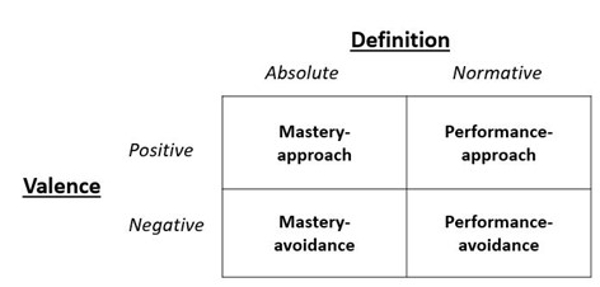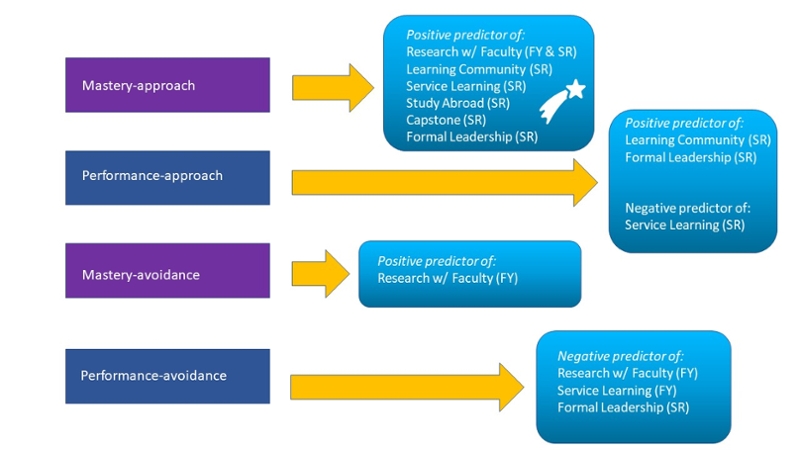The Mid-Western Educational Researcher, the journal sponsored by the Mid-Western Educational Research Association, recently published an article featuring findings from NSSE, specifically looking at whether achievement goal orientation predicts participation in high-impact practices. This article, originally a conference paper that won the MWERA 2021 Distinguished Paper Award, was authored by NSSE research scientist Angie Miller and used experimental item data from the 2015 NSSE administration.
Achievement goal orientation is an ongoing area of research within educational psychology (Elliot & Hulleman, 2017). Although the self-report measures of the construct have been developed and validated using convenience samples of undergraduates (Elliot, 2006; Elliot & Murayama, 2008), the practical applications are frequently focused on K-12 students and classrooms. Yet from a conceptual perspective, achievement goal orientation could be related to a variety of higher education experiences as well. For instance, other NSSE research on this topic found connections to student engagement and consistency across subgroups of students.
This study focuses on achievement goal orientation in relation to high-impact practices. Specifically, these four types of achievement goal orientations were measured:
- mastery-approach, where the goal is attaining task-based or intrapersonal competence (i.e. learning as much about the topic as possible);
- performance-approach, where the goal is attaining normative competence (i.e. getting a better grade than everyone else);
- mastery-avoidance, where the goal is avoiding task-based or intrapersonal incompetence (i.e. not wanting to miss out on important information about a topic); and
- performance-avoidance, where the goal is avoiding normative incompetence (i.e. not looking “stupid” in front of others)
Figure 1: 2 x 2 Achievement Goal Orientation Framework

Note: Adapted from Elliot & McGregor (2001)
Data were drawn from over 3,900 first-year and 5,200 senior college students across 15 higher education institutions participating in the 2015 National Survey of Student Engagement (NSSE), using an experimental item set that included a well-known measure of achievement goal orientation (the AGQ-R). In this measure, each of the four orientations has an accompanying subscale.
A series of binary logistic regression analyses, controlling for sex, transfer status, enrollment status, first-generation status, age, SAT/ACT, institutional control, enrollment size, race/ethnicity, major field, grades, percentage of online courses, and Honors College status, used the four orientations as predictor variables, with three HIPs as the outcome variables for first-years (learning community, a research project with a faculty member, and a service-learning project) and seven HIPs for seniors (learning community, study abroad, a research project with a faculty member, an internship, a culminating senior experience, a community-based project or service-learning project, and a formal leadership role on campus).
The most consistent finding was that students who are higher on mastery-approach orientation are more likely to partake in several different HIPs, including learning communities, research with faculty, service learning, study abroad, culminating experience, and formal leadership roles. However, the results for the remaining achievement goal orientations were more mixed. Some were positive predictors for certain HIPs, others were negative predictors, and there were some non-significant findings as well. A few of these patterns were also different for first-year students, compared to seniors.
Figure 2.Summary of Regression Model Findings

This study adds to the research supporting achievement goal orientation as one factor in how students experience their education. Institutions looking to increase students’ mastery-approach orientation might develop curricular and programming interventions toward this end. They could train faculty who supervise HIPs to adopt these interventions, such as designing tasks that are moderately challenging, inquiry-based, and optimize student choice regarding topic, off-campus site, type of organization, etc. to stimulate their intrinsic motivation. Furthermore, because some HIPs include grades and course credit while others are optional, administrators might consider revising current policies related to grades and HIPs in order to de-emphasize grades. This might instead encourage students to participate in HIPs of interest, focusing on mastery of the corresponding skills and content knowledge.
Given the potential benefits of HIP participation (Kilgo et al., 2015), we should encourage students with all types of achievement goal orientation to engage in these experiences. In addition to continued resource allocation for their implementation, the associated faculty, advisors, and administrators can work to better develop and implement HIP experiences that appeal to a wider variety of students. This may mean focusing efforts to include students who might not initially gravitate towards HIPs or updating program features to stimulate broader participation.
Reference
Miller, A. L. (2022). Achievement goal orientation as a predictor of high-impact practice participation for postsecondary students. Mid-Western Educational Research Journal, 34(3), 223-246.https://www.mwera.org/MWER/volumes/v34/issue3/MWER-V34n3-Miller-DISTINGUISHED-PAPER.pdf




